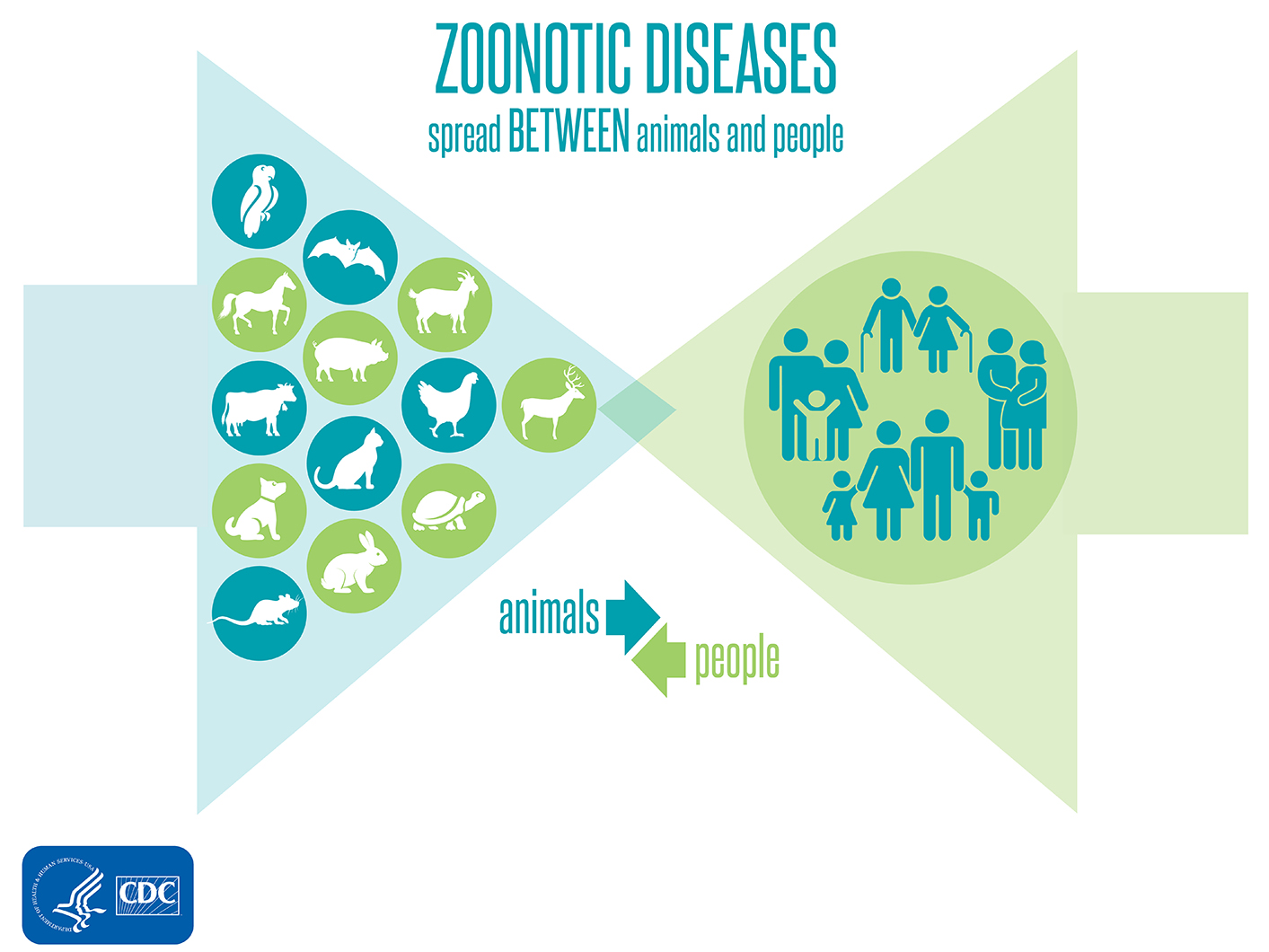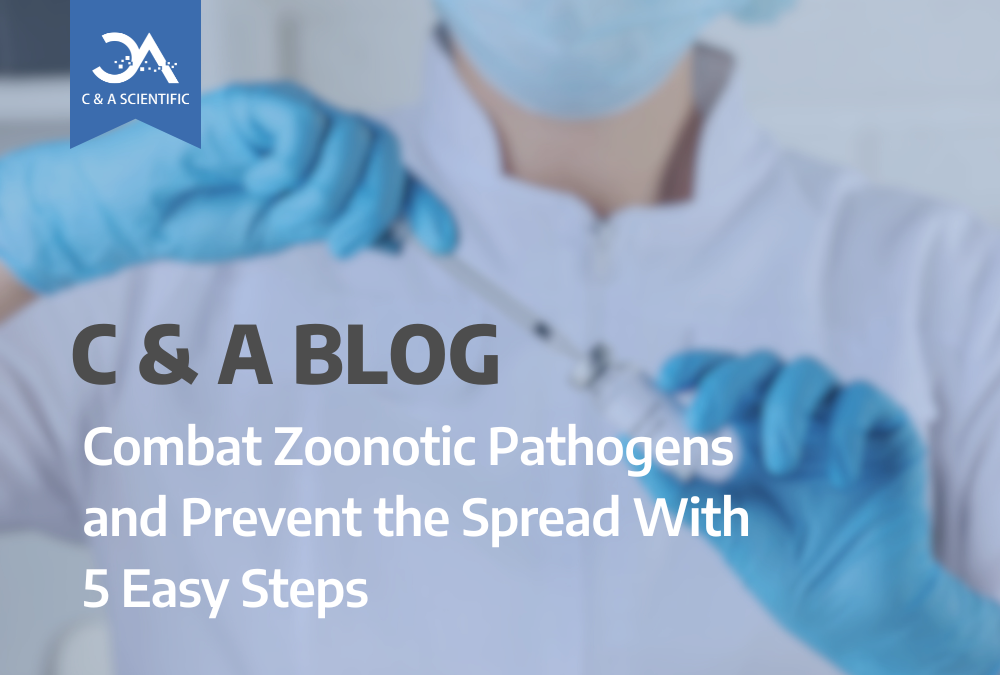Zoonotic pathogens have been a popular discussion topic ever since COVID-19, but what exactly are zoonotic pathogens? Even if you aren’t familiar with the term, you’ve probably heard of widespread zoonotic pathogens, such as rabies and cat scratch disease.
This blog will teach you about zoonosis, how hosts carry and spread pathogens, and how to prevent future spread.
TABLE OF CONTENTS
- What is Zoonosis?
- What Causes Zoonotic Pathogens?
- Source, Recipient, and Intermediate Hosts
- Source Hosts
- Recipient Hosts
- Intermediate Hosts
- Zoonotic Pathogen Spillover
- How Can I Prevent the Spread of Zoonotic Pathogens?
- Become a Vegetarian
- Advocate for Antibiotics
- Support Organic Farming
- Practice Good Hygiene
- Vaccinate Your Pets
- C & A Scientific’s Commitment
What is Zoonosis?
Zoonosis is an infectious disease transferred to humans from Over half of all infectious diseases come from a zoonotic origin. Zoonotic diseases of the past include the following:
- Severe acute respiratory syndrome (SARS)
- Human Immunodeficiency Virus (HIV) infection
- West Nile fever
- Zika virus
- Ebola virus
What Causes Zoonotic Pathogens?
One major cause of zoonotic pathogens is land-use change, or when humans alter a natural landscape to suit their needs. For example, deforestation (removing trees) and afforestation (planting trees) can impact the climate and wildlife. These activities can contribute to species isolation and confinement, which increases the likelihood of zoonotic pathogen spillover.
Zoonotic pathogen spillover means that a virus has spread from species to species.
This phenomenon refers to how a confined species can transmit pathogens through the following:
- Blood
- Biofluids
- Aerosols
- Contaminated surfaces
In understanding how these pathogens spread, it is important to learn about the different types of hosts that carry the disease.
Source, Recipient, and Intermediate Hosts
Zoonotic spillover typically happens when three species of pathogen hosts are involved. These include the source host, recipient host, and intermediate host.
Source Host
The source host is the first species that develops the pathogen or virus that causes disease.
Recipient Host
The recipient host is the species infected with the virus from the original host.
Intermediate Host
The intermediate host is the species that acts as a bridge between the recipient/source hosts and human infection. Humans can be infected in various ways, whether through biofluid exposure, eating meat, or contaminated water.
Intermediate hosts include pets like dogs and cats. These animals pick up and bring viruses into the home when kept outside.
Zoonotic Pathogen Spillover
One significant factor in zoonotic spillover is the nature of a pathogen. Viruses with an (set of genes that do not replicate on their own) will mutate faster than other viruses, allowing these viruses to adapt to other species more quickly.
Another essential factor to consider is the widespread use of standard antibiotics as a cure-all in veterinary medicine. While this general administration of antibiotics may prevent bacterial infection, it is also responsible for pushing animal bodies to create antibiotic-resistant strains of the disease.
This antibiotic administration is most common in the meat industry. This industry has continued to use antibiotics to respond to a risk-benefit matrix that prioritized the benefit of cheaply sourcing meat over the implied health risks of widespread antibiotic administration.

How Can I Prevent the Spread of Zoonotic Pathogens?
Here are five ways you can prevent the spread of zoonotic pathogens.
1. Become Vegan or Vegetarian
One way you can prevent the spread of zoonotic pathogens is by opting out of the meat industry. A considerable element of land-use change is the need to create spaces for animal agriculture. You will be advocate for decreased land-use change if you become vegan or vegetarian.
2. Advocate for Antibiotics
Additionally, you can advocate for the minimal use of antibiotics in farming and agriculture. While antibiotics improve cost ratios for farmers, they also decrease animals’ abilities to develop resistance to pathogens.
3. Support Organic Farming
Farming practices typically separate animals from their parents earlier than in the wild. As a result, their bodies do not receive naturally beneficial bacteria. You can advocate for organic farming rather than industrial farming to discourage these two factors that contribute to zoonotic pathogens.
4. Practice Good Hygiene
If exposed to larger animal populations, you can help prevent the spread of pathogens by practicing good hygiene. Practicing good hygiene includes but is not limited to the following:
- Washing your hands when handling animals
- Wearing coveralls or laboratory coats when caring for animals
- Avoiding eating in animal stalls or habitats
- Wearing gloves
- Minimizing exposure to biohazardous material when possible
5. Vaccinate Your Pets
Even if your pet is only exposed to you, keeping them up to date on vaccinations, parasite prevention, and medications is vital, so they do not become an intermediate host. Quarantine your pet from other animals if they show any sign of disease.
C & A Scientific’s Commitment
Help prevent the spread of zoonotic pathogens by following the recommended healthcare professional guidelines. C & A is here to provide you with the information you need to navigate the future of pandemics. To learn more about Covid-19 treatment methods, check out our blog on Molnupiravir.
At C & A, we aim to provide medical information to improve the health and minds of people worldwide. For over 30 years, we have worked in developing and manufacturing over 700 medical and STEM (Science, Technology, Engineering, and Math) products for distributors and retailers.
For more information about the products we provide and what we do, visit our About Us section here!


